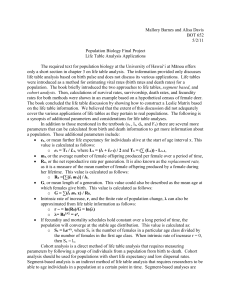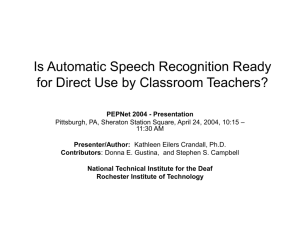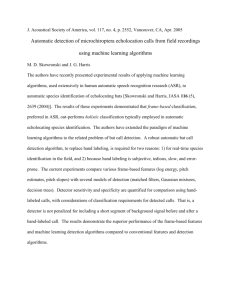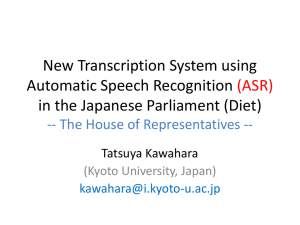Segment-Based Speech Recognition Introduction Searching graph-based observation spaces Modelling landmarks
advertisement
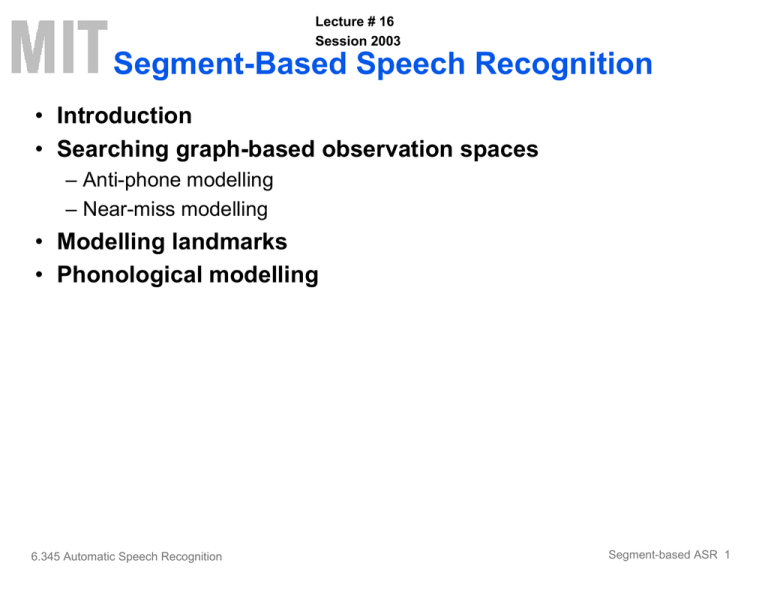
Lecture # 16
Session 2003
Segment-Based Speech Recognition
• Introduction
• Searching graph-based observation spaces
– Anti-phone modelling
– Near-miss modelling
• Modelling landmarks
• Phonological modelling
6.345 Automatic Speech Recognition
Segment-based ASR 1
Segment-Based Speech Recognition
Waveform
Frame-based measurements (every 5ms)
Segment network created by interconnecting spectral landmarks
p
-
k
ax m
-
computers
er
uw dx
ao
z dh ae
that
-
t
-
k
talk
Probabilistic search finds most likely phone & word strings
6.345 Automatic Speech Recognition
Segment-based ASR 2
Segment-based Speech Recognition
• Acoustic modelling is performed over an entire segment
• Segments typically correspond to phonetic-like units
• Potential advantages:
– Improved joint modelling of time/spectral structure
– Segment- or landmark-based acoustic measurements
• Potential disadvantages:
– Significant increase in model and search computation
– Difficulty in robustly training model parameters
6.345 Automatic Speech Recognition
Segment-based ASR 3
Hierarchical Acoustic-Phonetic Modelling
• Homogeneous measurements can compromise performance
% Classification Error
– Nasal consonants are classified better with a longer analysis window
– Stop consonants are classified better with a shorter analysis window
24
22
Nasal
Stop
20
18
16
10
12.5
15
17.5
20
22.5
25
27.5
30
Window Duration (ms)
• Class-specific information extraction can reduce error
6.345 Automatic Speech Recognition
Segment-based ASR 4
Committee-based Phonetic Classification
• Change of temporal basis affects within-class error
– Smoothly varying cosine basis better for vowels and nasals
– Piecewise-constant basis better for fricatives and stops
30
% Error
28
26
24
S1: 5 averages
S3: 5 cosines
Stop
Weak
Fricative
Nasal
Vowel
20
Overall
22
• Combining information sources can reduce error
6.345 Automatic Speech Recognition
Segment-based ASR 5
Phonetic Classification Experiments
(A. Halberstadt, 1998)
• TIMIT acoustic-phonetic corpus
– Context-independent classification only
– 462 speaker training corpus, 24 speaker core test set
– Standard evaluation methodology, 39 common phonetic classes
• Several different acoustic representations incorporated
– Various time-frequency resolutions (Hamming window 10-30 ms)
– Different spectral representations (MFCCs, PLPCCs, etc)
– Cosine transform vs. piecewise constant basis functions
• Evaluated MAP hierarchy and committee-based methods
Method
Baseline
MAP Hierarchy
Committee of 8 Classifiers
Committee with Hierarchy
6.345 Automatic Speech Recognition
* Development set performance
% Error
21.6
21.0
18.5*
18.3
Segment-based ASR 6
Statistical Approach to ASR
P (W )
Language
Model
Linguistic
Decoder
W
Speech
Signal
Processor
A
Words W
*
Acoustic
Model
P ( A|W )
• Given acoustic observations, A, choose word sequence, W*,
which maximizes a posteriori probability, P(W |A)
W * = argmax P ( W | A)
W
• Bayes rule is typically used to decompose P(W |A) into
acoustic and linguistic terms
P ( A | W )P ( W )
P ( W | A) =
P ( A)
6.345 Automatic Speech Recognition
Segment-based ASR 7
ASR Search Considerations
• A full search considers all possible segmentations, S, and
units, U, for each hypothesized word sequence, W
W * = argmax P (W | A) = argmax ∑∑ P (WUS | A)
W
W
S U
• Can seek best path to simplify search using dynamic
programming (e.g., Viterbi) or graph-searches (e.g., A*)
W * ,U * , S * ≈ arg max P (WUS | A)
W ,U ,S
• The modified Bayes decomposition has four terms:
P ( A | SUW )P (S | UW )P (U | W )P (W )
P (WUS | A) =
P ( A)
In HMM’s these correspond to acoustic, state, and
language model probabilities or likelihoods
6.345 Automatic Speech Recognition
Segment-based ASR 8
Examples of Segment-based Approaches
• HMMs
– Variable frame-rate (Ponting et al., 1991, Alwan et al., 2000)
– Segment-based HMM (Marcus, 1993)
– Segmental HMM (Russell et al., 1993)
• Trajectory Modelling
– Stochastic segment models (Ostendorf et al., 1989)
– Parametric trajectory models (Ng, 1993)
– Statistical trajectory models (Goldenthal, 1994)
• Feature-based
– FEATURE (Cole et al., 1983)
– SUMMIT (Zue et al., 1989)
– LAFF (Stevens et al., 1992)
6.345 Automatic Speech Recognition
Segment-based ASR 9
Segment-based Modelling at MIT
• Baseline segment-based modelling incorporates:
– Averages and derivatives of spectral coefficients (e.g., MFCCs)
– Dimensionality normalization via principal component analysis
– PDF estimation via Gaussian mixtures
• Example acoustic-phonetic modelling investigations, e.g.,
–
–
–
–
–
–
–
Alternative probabilistic classifiers (e.g., Leung, Meng)
Automatically learned feature measurements (e.g., Phillips, Muzumdar)
Statistical trajectory models (Goldenthal)
Hierarchical probabilistic features (e.g., Chun, Halberstadt)
Near-miss modelling (Chang)
Probabilistic segmentation (Chang, Lee)
Committee-based classifiers (Halberstadt)
6.345 Automatic Speech Recognition
Segment-based ASR 10
SUMMIT Segment-Based ASR
• SUMMIT speech recognition is based on phonetic segments
–
–
–
–
Explicit phone start and end times are hypothesized during search
Differs from conventional frame-based methods (e.g., HMMs)
Enables segment-based acoustic-phonetic modelling
Measurements can be extracted over landmarks and segments
dh
-
k
x
n
m
p
- p
uw
h
d
er
er
eh
ae
z
z
-
t
aa
aa
v
-
k
-
• Recognition is achieved by searching a phonetic graph
– Graph can be computed via acoustic criterion or probabilistic models
– Competing segmentations make use of different observation spaces
– Probabilistic decoding must account for graph-based observation space
6.345 Automatic Speech Recognition
Segment-based ASR 11
“Frame-based” Speech Recognition
• Observation space, A, corresponds to a temporal sequence
of acoustic frames (e.g., spectral slices)
A = {a1a2a3}
a2
a1
a1 a2
a3
a2 a3
• Each hypothesized segment, si, is represented by the series
of frames computed between segment start and end times
• The acoustic likelihood, P(A|SW), is derived from the same
observation space for all word hypotheses
P(a1 a2 a3 |SW)
6.345 Automatic Speech Recognition
⇔ P(a1 a2 a3 |SW) ⇔ P(a1 a2 a3 |SW)
Segment-based ASR 12
“Feature-based” Speech Recognition
• Each segment, si, is represented by a single feature vector, ai
A = {a1a2a3a4a5}
a3
a1
a2
X = {a1a3a5}
Y = {a2a4}
a5
a4
X = {a1a2a4a5}
Y = {a3}
• Given a particular segmentation, S, A consists of X, the
feature vectors associated with S, as well as Y, the feature
vectors associated with segments not in S: A = X UY
• To compare different segmentations it is necessary to
predict the likelihood of both X and Y: P(A|SW) = P(XY|SW)
P(a1a3a5 a2a4 |SW) ⇔ P(a1a2a4a5 a3 |SW)
6.345 Automatic Speech Recognition
Segment-based ASR 13
Searching Graph-Based Observation Spaces:
The Anti-Phone Model
• Create a unit, α , to model segments that are not phones
• For a segmentation, S, assign anti-phone to extra segments
– All segments are accounted for in the phonetic graph
– Alternative paths through the graph can be legitimately compared
α-
αk αx αn αp uw
α αd
m α
- α α
α
er
α
α
dh
α
αz
α
eh
α
ae
α
α-
αt
aa
α
aa
α
αv α- αk
α-
• Path likelihoods can be decomposed into two terms:
1 The likelihood of all segments produced by the anti-phone (a constant)
2 The ratio of phone to anti-phone likelihoods for all path segments
• MAP formulation for most likely word sequence, W, given by:
NS
P ( x i | ui )
W = argmax ∏
P (si | ui )P (U | W )P (W )
W ,S i P ( xi | α )
*
6.345 Automatic Speech Recognition
Segment-based ASR 14
Modelling Non-lexical Units:
The Anti-phone
• Given a particular segmentation, S, A consists of X, the
segments associated with S, as well as Y, the segments not
associated with S: P(A|SU)=P(XY|SU)
• Given segmentation S, assign feature vectors in X to valid
units, and all others in Y to the anti-phone
• Since P ( XY | α ) is a constant, K, we can write P(XY|SU)
assuming independence between X and Y
P( X | α)
P( X | U )
P ( XY | SU ) = P ( XY | U ) = P ( X | U )P (Y | α )
=K
P( X | α)
P( X | α)
• We need consider only segments in S during search:
*
NS
P ( xi | U )
∏
P( x
W ,U ,S
W = arg max
i
6.345 Automatic Speech Recognition
i | α)
P (si | ui )P (U | W )P (W )
Segment-based ASR 15
SUMMIT Segment-based ASR
6.345 Automatic Speech Recognition
Segment-based ASR 16
Anti-Phone Framework Properties
• Models entire observation space, using both positive and
negative examples
• Log likelihood scores are normalized by the anti-phone
–
–
–
–
Good scores are positive, bad scores are negative
Poor segments all have negative scores
Useful for pruning and/or rejection
Anti-phone is not used for lexical access
• No prior or posterior probabilities used during search
– Allows computation on demand and/or fastmatch
– Subsets of data can be used for training
• Context-independent or -dependent models can be used
• Useful for general pattern matching problems with graphbased observation spaces
6.345 Automatic Speech Recognition
Segment-based ASR 17
Beyond Anti-Phones: Near-Miss Modelling
• Anti-phone modelling partitions the observation space into
two parts (i.e., on or not on a hypothesized segmentation)
• Near-miss modelling partitions the observation space into
a set of mutually exclusive, collectively exhaustive subsets
– One near-miss subset pre-computed for each segment in a graph
– Temporal criterion can guarantee proper near-miss subset generation
(e.g., segment A is a near-miss of B iff A’s mid-point is spanned by B)
dh
A
-
k
x
B
m A
A
p
uw
d
er
z
A
B
eh
-
t
k
aa
-
• During recognition, observations in a near-miss subset are
mapped to the near-miss model of the hypothesized phone
• Near-miss models can be just an anti-phone, but can
potentially be more sophisticated (e.g., phone dependent)
6.345 Automatic Speech Recognition
Segment-based ASR 18
Creating Near-miss Subsets
• Near-miss subsets, Ai, associated with any segmentation, S,
must be mutually exclusive, and exhaustive: A = U Ai ∀Ai∈S
• Temporal criterion guarantees proper near-miss subsets
– Abutting segments in S account for all times exactly once
– Finding all segments spanning a time creates near-miss subsets
a5
a3
a1
a4
a2
a1∈A1,A2
a2∈A1,A2
A1 = {a1a2}
A2 = {a1a2a3}
a3∈A2,A3,A4
A3 = {a3}
a4∈A4,A5
A4 = {a3a4a5}
a5∈A4,A5
A5 = {a4a5}
A = U Ai ∀ S S = {{a1a3a5}, {a1a4}, {a2a5}}
6.345 Automatic Speech Recognition
Segment-based ASR 19
Modelling Landmarks
• We can also incorporate additional feature vectors
computed at hypothesized landmarks or phone boundaries
dh
-
k x
p
n
m
-
uw
d
er
z
eh
ae
-
t
aa
v
-
k
-
aa
• Every segmentation accounts for every landmark
– Some landmarks will be transitions between lexical-units
– Other landmarks will be considered internal to a unit
• Both context-independent or dependent units are possible
• Effectively model transitions between phones (i.e., diphones)
• Frame-based models can be used to generate segment graph
6.345 Automatic Speech Recognition
Segment-based ASR 20
Modelling Landmarks
• Frame-based measurements:
– Computed every 5 milliseconds
– Feature vector of 14 Mel-Scale Cepstral Coefficients (MFCCs)
Frame-based feature vectors
Landmarks
• Landmark-based measurements:
– Compute average of MFCCs over 8 regions around landmark
– 8 regions X 14 MFCC averages = 112 dimension vector
– 112 dims. reduced to 50 using principal component analysis
6.345 Automatic Speech Recognition
Segment-based ASR 21
Probabilistic Segmentation
• Uses forward Viterbi search in first-pass to find best path
a
Lexical Nodes
r
z
m
h#
t0
t1
t2
t3
t4
t5
t6
t7
t8
Time
• Relative and absolute thresholds used to speed-up search
6.345 Automatic Speech Recognition
Segment-based ASR 22
Probabilistic Segmentation (con’t)
• Second pass uses backwards A* search to find N-best paths
• Viterbi backtrace is used as future estimate for path scores
a
Lexical Nodes
r
z
m
h#
t0
t1
t2
t3
t4
t5
t6
t7
t8
Time
• Block processing enables pipelined computation
6.345 Automatic Speech Recognition
Segment-based ASR 23
Phonetic Recognition Experiments
• TIMIT acoustic-phonetic corpus
– 462 speaker training corpus, 24 speaker core test set
– Standard evaluation methodology, 39 common phonetic classes
• Segment and landmark representations based on averages
and derivatives of 14 MFCCs, energy and duration
• PCA used for data normalization and reduction
• Acoustic models based on aggregated Gaussian mixtures
• Language model based on phone bigram
• Probabilistic segmentation computed from diphone models
Method
Triphone CDHMM
Recurrent Neural Network
Bayesian Triphone HMM
Anti-phone, Heterogeneous classifiers
6.345 Automatic Speech Recognition
% Error
27.1
26.1
25.6
24.4
Segment-based ASR 24
Phonological Modelling
• Words described by phonemic baseforms
• Phonological rules expand baseforms into graph, e.g.,
– Deletion of stop bursts in syllable coda
(e.g., laptop)
– Deletion of /t/ in various environments
(e.g., intersection, destination, crafts)
– Gemination of fricatives and nasals
(e.g., this side, in nome)
– Place assimilation
(e.g., did you (/d ih jh uw/))
• Arc probabilities, P(U|W), can be trained
• Most HMMs do not have a phonological component
6.345 Automatic Speech Recognition
Segment-based ASR 25
Phonological Example
• Example of “what you” expanded in SUMMIT recognizer
– Final /t/ in “what” can be realized as released, unreleased, palatalized,
or glottal stop, or flap
“what”
6.345 Automatic Speech Recognition
“you”
Segment-based ASR 26
Word Recognition Experiments
• Jupiter telephone-based, weather-queries corpus
– 50,000 utterance training set, 1806 “in-domain” utterance test set
• Acoustic models based on Gaussian mixtures
– Segment and landmark representations based on averages and
derivatives of 14 MFCCs, energy and duration
– PCA used for data normalization and reduction
– 715 context-dependent boundary classes
– 935 triphone, 1160 diphone context-dependent segment classes
• Pronunciation graph incorporates pronunciation probabilities
• Language model based on class bigram and trigram
• Best performance achieved by combining models
Method
Boundary models
Segment models
Combined
6.345 Automatic Speech Recognition
% Error
7.6
9.6
6.1
Segment-based ASR 27
Summary
• Some segment-based speech recognition techniques
transform the observation space from frames to graphs
• Graph-based observation spaces allow for a wide-variety of
alternative modelling methods to frame-based approaches
• Anti-phone and near-miss modelling frameworks provide a
mechanism for searching graph-based observation spaces
• Good results have been achieved for phonetic recognition
• Much work remains to be done!
6.345 Automatic Speech Recognition
Segment-based ASR 28
References
• J. Glass, “A Probabilistic Framework for Segment-Based
Speech Recognition,” to appear in Computer, Speech &
Language, 2003.
• D. Halberstadt, “Heterogeneous Acoustic Measurements
and Multiple Classifiers for Speech Recognition,” Ph.D.
Thesis, MIT, 1998.
• M. Ostendorf, et al., “From HMMs to Segment Models: A
Unified View of Stochastic Modeling for Speech
Recognition,” Trans. Speech & Audio Proc., 4(5), 1996.
6.345 Automatic Speech Recognition
Segment-based ASR 29
